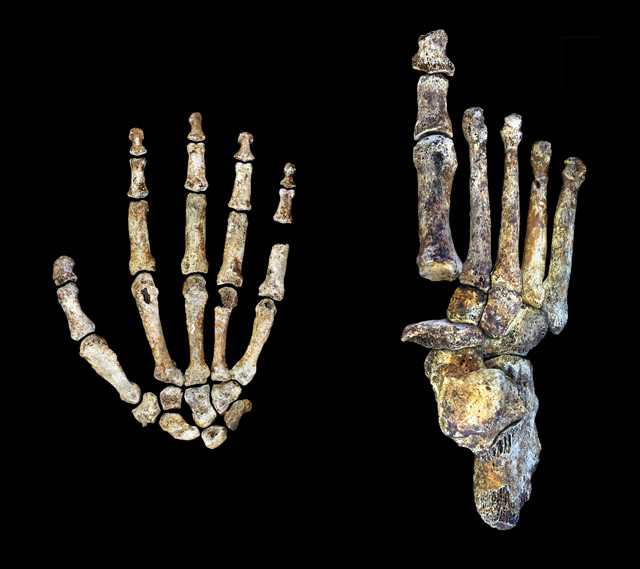
by Mary Caperton Morton Friday, January 8, 2016

The hand and foot of the newly discovered hominin species, Homo naledi. Credit: Peter Schmid/Will Harcourt-Smith.
After dozens of human-like fossils were discovered in a cave in South Africa last summer, they were declared distinct enough to be classified as a new species: Homo naledi. Two recent studies looking in detail at the new hominid’s hands and feet are revealing how different they were from other early humans.
Human feet have more than two dozen bones, the shape and structure of which reveal a lot about a species’ locomotion and lifestyle. Close examination of 107 foot bones belonging to at least five individuals suggests that H. naledi was well-adapted for standing and walking on two feet, but that it also was likely adept at climbing trees, according to a study in Nature Communications.
“Homo naledi’s foot is far more advanced than other parts of its body, for instance, its shoulders, skull, or pelvis,” said William Harcourt-Smith, a paleoanthropologist at the American Museum of Natural History in New York and lead author of the new study, in a statement. “Quite obviously, having a very human-like foot was advantageous to this creature because it was the foot that lost its primitive, or ape-like, features first. That can tell us a great deal in terms of the selective pressures this species was facing.”
Analysis of the foot bones showed that they appear to be closer in shape and size to modern human bones than chimpanzee bones, except that H. naledi’s toe bones were more curved and the arch of the foot was flatter than modern humans.
The rest of H. naledi’s anatomy — including its long, curved fingers and a more ape-like shoulder girdle — suggests they moved in their own unique way, somewhere between chimps and full bipeds. A study of the hominid’s hands, led by Tracy Kivell of the University of Kent in England, was published in the same issue of Nature Communications.
“This species has a unique combination of traits below the neck, and that adds another type of bipedalism to our record of human evolution,” Harcourt-Smith said. “There were lots of different experiments happening within hominins — it wasn’t just a linear route to how we walk today.”
© 2008-2021. All rights reserved. Any copying, redistribution or retransmission of any of the contents of this service without the expressed written permission of the American Geosciences Institute is expressly prohibited. Click here for all copyright requests.